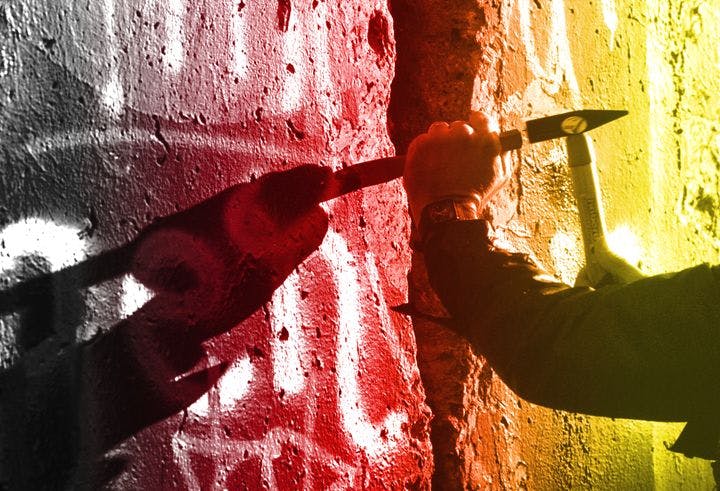Fall 2014
From Shame to Pride: the Fall of the Berlin Wall through German Eyes
– Hope M. Harrison
The decades-long story of how German shame that the Berlin Wall ever stood gave way to German pride that the Berlin Wall came down.
Twenty-five years ago, on November 9, 1989, the fall of the Berlin Wall was celebrated around the world. A happier ending couldn’t have been produced in Hollywood. Without a shot being fired, democracy and freedom triumphed over communism at the spot where a shoot-to-kill order had been rescinded only a few months before.
Germans and other lucky visitors to Berlin laughed and cried and danced on the Wall, and soon began to take home pieces of its remains as souvenirs. It was a global event, with international media broadcasting live as audiences watched at home. Americans in particular felt a connection to the story of freedom’s triumph over communist tyranny — indeed, more pieces of the Wall are now on display in the United States than are left in Berlin. As Berliners chiseled and hammered and celebrated on November 9, across the United States, millions of Americans gathered around their television sets with lumps in their throats as Tom Brokaw broadcasted live from the Brandenburg Gate. Berlin’s display of unbridled joy was infectious.
For most of the world, the Wall transformed overnight from a symbol of Cold War communist oppression into an icon of freedom. It would take the Germans 20 years to return to seeing the Wall in this way.
After all, they had lived with the Wall for almost three decades and endured the division of their country between communist East Germany and democratic, capitalist West Germany for more than four decades. For them, contemplating the history of the Berlin Wall was uncomfortable. Germans had shot Germans for trying to go from east to west. Following unification, there were trials of border guards and top military and political officials from the former communist German Democratic Republic (GDR), but otherwise the general public and German leaders tried their best to not think about the Wall. It was easier to leave it in the past and move on.
In those early days, the top priority for Berliners was to dismantle the border fortifications — double layers of outer and inner walls, patrol roads, signal wires, fences, guard towers, and dog runs — which comprised the Berlin Wall’s “death strip.” After 28 years, it was time to reunite the city. There were streets to be reopened, subway and train lines to be reattached, and waterways to be reconnected. In a unified Berlin, the Wall’s 27-mile-long gash through the heart of the city now represented desirable real estate, soon to be filled by shopping malls, roads, apartments, and offices.
Only a few people spoke up early on about the importance of remembering the history of the Wall and preserving some of it. The day after the Wall opened, former West Berlin mayor and West German chancellor Willy Brandt spoke to a crowd outside West Berlin’s city hall, pleading that “a piece of this dreadful edifice should be left standing as a historical monstrosity” for future generations to see. Protestant Pastor Manfred Fischer, whose congregation was split in two when the Wall was erected, actually stood in front of bulldozers to stop them from demolishing the Wall on Bernauer Strasse — the site of several deaths and escape attempts, and near to the site of Fischer’s former church — and insisted that a Berlin Wall memorial be built there instead. There was no broad public support for Brandt’s or Fischer’s views.
It would take a dramatic initiative in 2004, the 15th anniversary of the fall of the Wall, to induce German politicians, the media, and the broader public to devote more attention to the history of the Wall. The Germans would have to grapple with the worst part of the history of the Wall — the killing of people trying to escape from the GDR — before coming to celebrate the best part of the history of the Wall: its peaceful fall.
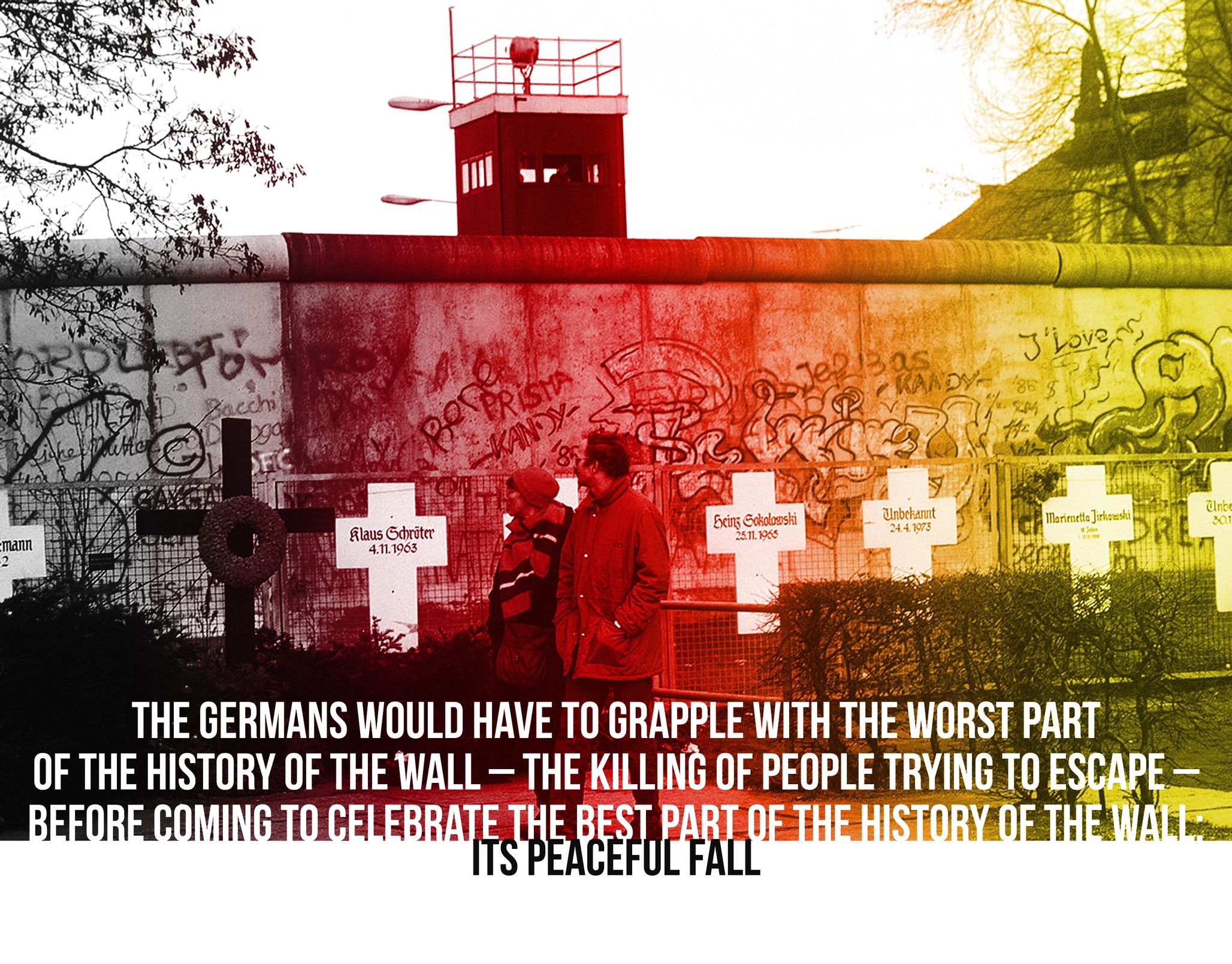
TWO WEEKS BEFORE THE 15TH ANNIVERSARY on November 9, 2004, Alexandra Hildebrandt, the head of the Checkpoint Charlie Museum (named after the famed East-West border post in Berlin), unveiled 1,065 wooden crosses dedicated to people who lost their lives along the former east-west borders in Berlin and Germany. Many of the crosses had a picture of a person killed at the border, their name, dates of birth and death, and the reason for their death — “shot while trying to escape,” “drowned after being shot,” each life lost remembered in a few words. Hildebrandt said that her “Freedom Memorial” was meant to be a “site of commemoration” to “remember victims of the German division and the Wall,” something she believed that politicians had failed to do.
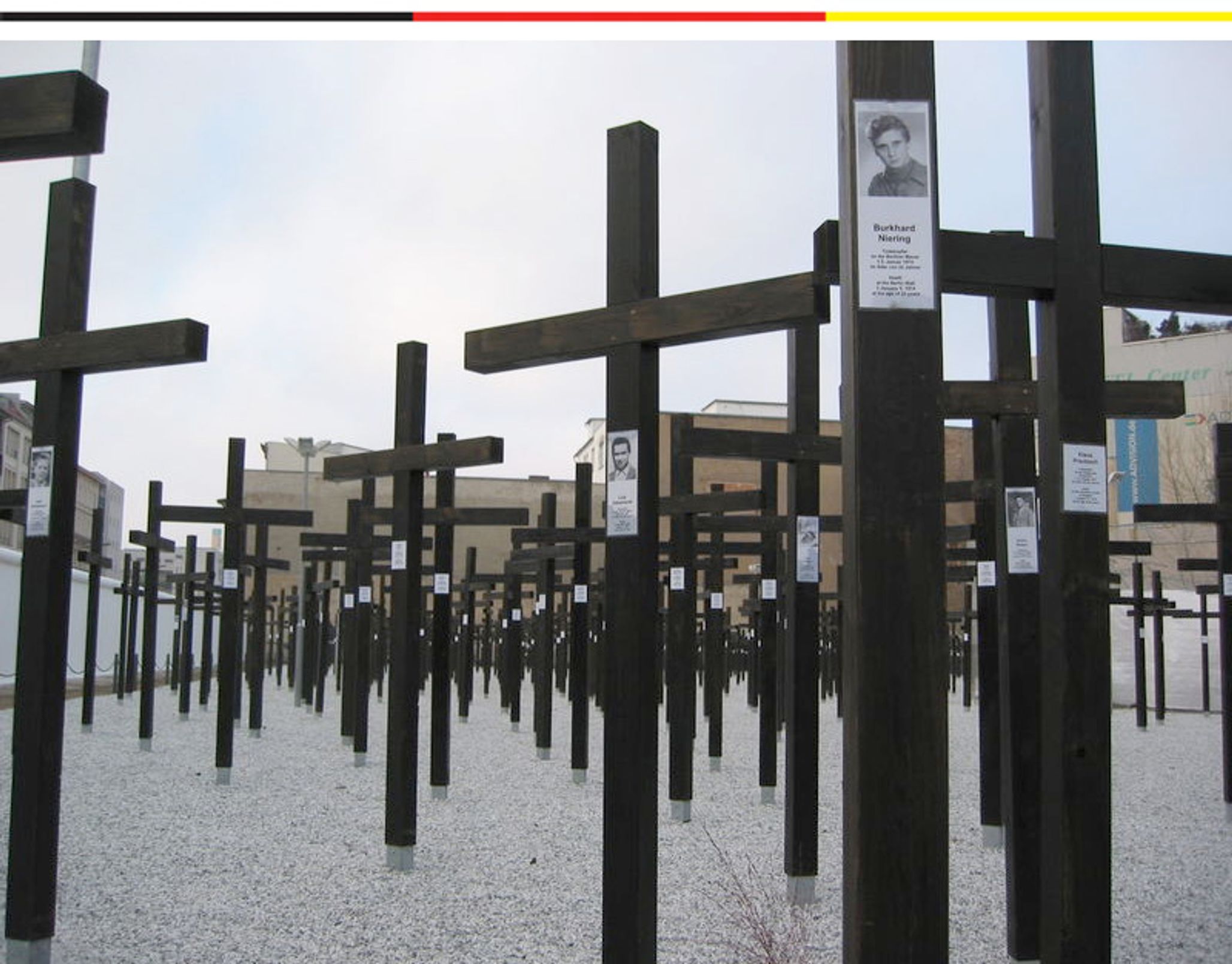
Joining Hildebrandt for the dedication of the crosses was Ursula Jünemann, the mother of Burkhard Niering, an East German guard killed in 1974 when he tried to escape at Checkpoint Charlie. “I stand here as a representative for all mothers and fathers here whose children perished at the Wall,” Jünemann told the crowd. She remembered how she felt when her son was killed: “I cried so much then, was so outraged at the state. This memorial is important. Also for my son.”
The days and weeks following the dedication of the memorial saw increasing calls for official action to commemorate the people killed at the Berlin Wall. Hildebrandt’s powerful memorial, the national and international press coverage of it, and the throngs of tourists who came to see it all got the attention of government officials. The Berlin Senate formed an interagency “Working Group on Remembering the Berlin Wall” to discuss what the state should do to remember and commemorate the Wall and its victims. They also knew that tourists from all over the world flocked to Berlin, eager to see the Wall and learn about it, and were frustrated at how difficult it was to find.
After a year and a half of consultations, meetings with historical experts, and public hearings, in 2006 the Senate adopted a “Master Plan for Remembering the Berlin Wall.” Taking a cue from Hildebrandt, the plan itself was dedicated to the victims of the Wall and to all who suffered because of the division of Germany and the policies of East Germany’s ruling Socialist Unity Party (Sozialistische Einheitspartei Deutschlands, or SED). The plan would preserve the few existing remains of the Wall at several sites in Berlin; create an expanded Berlin Wall Memorial at Bernauer Strasse as the main site for commemorating its victims individually and collectively; develop a small exhibit on the Wall in the new subway station at the Brandenburg Gate; erect new signs and historical markers at key sites connected with the Wall; and generally make it easier for people to learn about the history of the Berlin Wall by developing websites, smartphone apps, and tour routes.
The federal government supported this master plan and contributed some funds as well. It also sponsored the first scholarly investigation to ascertain who exactly had been killed at the Wall and what had led them to try to escape. Hildebrandt’s museum had no scholarly board of advisors, and she provided no background on how she arrived at the number of 1,065 victims at the Wall and the inner-German border (a figure she soon increased to 1,075, adding 10 new names without firm proof). Between 2006 and 2008, a pair of scholars from the Center for Contemporary History in Potsdam and the Berlin Wall Memorial undertook a study and found conclusive evidence that approximately 136 people had died at the Berlin Wall. Pastor Fischer began reading out their names and incorporating short biographies into services at the Church of Reconciliation at Bernauer Strasse in 2005. A few years later, the federal government would fund a similar study about people who died at the nearly 900-mile-long border between East and West Germany.
Of course, this project was not the first time that the Germans had given names to their victims and counted their numbers. Both the weight of the Holocaust and German attempts to grapple with this history have influenced their approach to victims of the Wall and the East German regime. It has sparked difficult, emotional debates, especially as some commentary has referred to “the two German dictatorships of the twentieth century.” For many Germans, particularly from the former West, the powerful, often-used German terms Vergangenheitsbewältigung (coming to terms with the past) or Aufarbeitung der Geschichte (working through history) should apply only to discussions of the Nazi past and its uniquely horrific, mass crimes against the Jews during the Holocaust. They fear that studying the history of another group of German victims — victims of the Berlin Wall — risks distracting attention from the Jewish victims of the Nazi regime, and leads to a competition of victimhood. Any sort of comparison of Nazi and East German communist crimes may lead to the false conclusion that these crimes were indeed comparable, and thus might downplay what the Nazis did. A further aspect of competition between those who focus on the Nazi past and those who concentrate on the East German past is the shared date of November 9 — which was not only the date of the fall of the Wall, but also the date of Kristallnacht, the “Night of Broken Glass” when the Nazis attacked synagogues, Jewish stores, homes, and other sites in 1938.
Some feared a competition of victimhood: that acknowledging the fact that Germans were victims of the Wall would divert sympathies from those whom Germans had victimized decades earlier.
After years of contentious discussions about how to treat the Nazi and communist parts of German history, in 2008 the Bundestag finally agreed on guidelines: “Any remembrance of the dictatorial past in Germany must proceed from the understanding that the National Socialist crimes should not be relativized, nor should the SED dictatorship’s injustices be downplayed.” The Bundestag made it clear that the “Holocaust was unique … in its systematic aim of genocide” but nonetheless declared that “it is also the task of the state and society to remember the injustices of the SED dictatorship and commemorate the victims of communism in Germany. For years behind the Wall and barbed wire, people suffered from lack of freedom, repression and pressure to conform.”
The process leading to German commemoration of the victims of the Wall was also helped by the dedication of the Memorial to the Murdered Jews of Europe in 2005. With its location (the center of Berlin, next to the Brandenburg Gate) and sprawling size (2,711 sarcophagus-like concrete blocks), the somber monument is an unequivocal acknowledgment of the horrors that Nazi Germany inflicted on European Jews. In a sense, the completion of the long-discussed Holocaust Memorial made it easier for Germans to consider another group of victims: the victims of the Wall.

For very different reasons, Germany’s hosting of the 2006 World Cup soccer championships facilitated a new way of thinking about being German and about the history of the Wall — a more positive view — that would take hold a few years later.
The devastating human toll of German nationalism in the first half of the 20th century has made it difficult for Germans to show patriotism ever since. Unlike in the United States, where it is common for people to hang the American flag in front of their house or to wear a flag pin on their lapels, public displays of patriotism are highly unusual in Germany (and make most Germans above the age of 40 or so quite uncomfortable). But in 2006 (as they would again in 2014), young German soccer fans did what their peers from other countries did: they cheered on the national team; carried their flag to games; flew the German banner from their cars; and dressed themselves (and painted their bodies) in the national colors of black, red, and gold. They did this jubilantly and peacefully, not aggressively — to the great relief of older Germans, some of whom joined in only after great hesitation.
.jpg)
It felt okay to be German. It felt normal to wave the flag and scream, “Go Deutschland!” Germany came in third place in 2006, and Italy beat France in the finals, but it was okay. It had been fun. The Germans felt a bit lighter afterwards and began to see aspects of their national history in a more positive way. The following year, in November 2007, the Bundestag passed a resolution to sponsor the creation of a Freedom and Unity Monument to celebrate the fall of the Wall and the unification of Germany. As Bundestag vice president Wolfgang Thierse, who had participated in the civil rights movement against the East German regime, noted during the debate about the resolution: “We Germans should muster all of our courage and remember with a monument that German history can also go well for once, and did go well.” He and others wanted to draw attention to the fact that “the GDR population set in motion the first and only successful peaceful revolution that Germany has experienced.”
Like Thierse, Tom Sello had also been in the East German opposition. Since 2003, Sello had been developing plans for an exhibit about the 1989 East German protests that contributed first to the fall of the Wall and then to German unification. In 2003, Germans devoted great attention to commemorating the 50th anniversary of the 1953 East German popular uprising, which had been put down brutally by Soviet tanks. Sello believed strongly that the events of 1989 deserved at least as much attention, and that the East German peaceful revolution (Friedliche Revolution) of 1989 was not fully understood by most Germans, especially those from the West. He wanted to change this, and the twentieth anniversary of the fall of the Wall in 2009 was the perfect chance. He also felt that the Senate’s “Master Plan on Remembering the Berlin Wall” did not include enough about the background leading to the fall of the Wall and the important role of the East German opposition. He wanted to make clear that the fall of the Wall was part of the peaceful revolution and not vice versa.
Berlin Mayor Klaus Wowereit declared that 2009 would be devoted to celebrating the fall of the Wall. He was looking for inspiring ideas about how to do this, and Sello’s idea for an exhibit on the peaceful popular revolution fit the bill. The city of Berlin and the federal government funded the exhibit “‘We are the People!’ The Peaceful Revolution 1989/90,” which opened in May 2009. The exhibit was located in Alexanderplatz, the largest square in what had been East Berlin, where 500,000 people had demonstrated on November 4, 1989, calling upon the East German government to make democratic reforms, including expansions of the right to travel. In opening the exhibit, Mayor Wowereit observed that “20 years since the Peaceful Revolution and 20 years since the fall of the Wall are occasions to commemorate, to remember, and to be proud of what has been achieved.”
Throughout 2009, it became increasingly common for German politicians to use the word “proud” in describing their sentiments about the fall of the Wall. Beginning with the exhibit in May and moving toward the anniversary in November, what had been a minority view of the essential role of the East German people in bringing down the Wall — and the communist regime behind it — received widespread official sanction and would become a crucial new addition to the official German historical narrative. Until 2009, the dramatic events of 1989 had been referred to rather passively as “the turning point” or “the change” (die Wende). This was now thrown aside in favor of the more forceful term “Peaceful Revolution” — capital P, capital R.
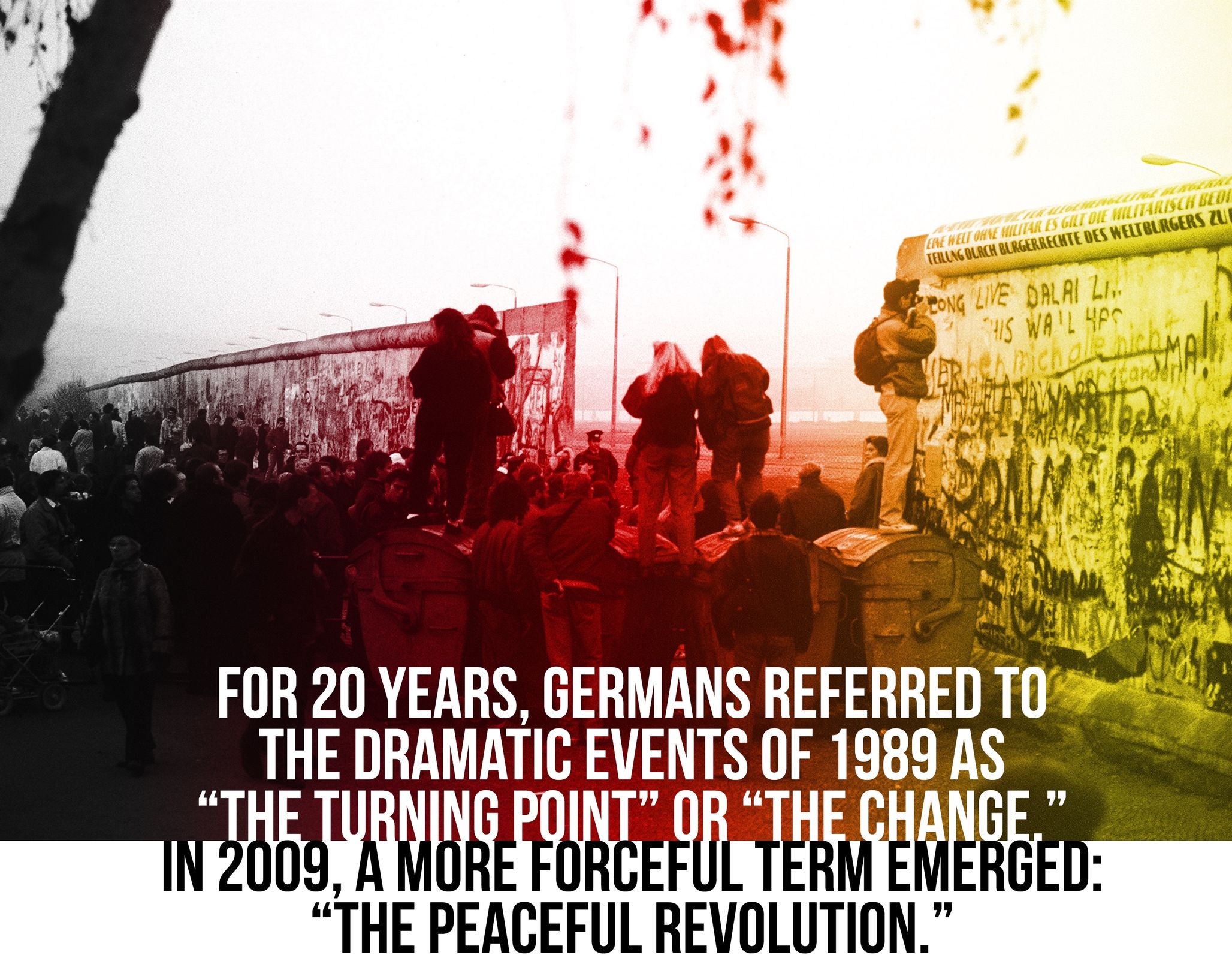
Initially, the federal government under Chancellor Angela Merkel was much less engaged in celebrating the fall of the Wall than the city of Berlin was, arguing that it was a matter for the city, not the country, to coordinate. However, the increase in calls to the chancellor’s office that summer from foreign leaders and news organizations who wanted to participate in the twentieth anniversary celebrations in November led to more active involvement by the chancellery. So many people around the globe still felt inspired by the fall of the Wall, and their sentiments had an impact on German policy. The combination of Sello’s exhibit emphasizing the East German Peaceful Revolution and worldwide interest in marking the fall of the Wall helped the chancellor and others to embrace a festive approach to the twentieth anniversary. Merkel would ultimately invite key representatives of the former East German civil rights movement to join her and leaders from the United States, Russia, and the 26 other member states of the European Union to celebrate in Berlin on November 9, 2009.
The city of Berlin had put out a call to school classes and to other groups from Germany and around the world to participate in the 20th anniversary of the fall of the Wall by painting eight-foot-tall foam replicas of pieces of the Wall with related historical themes. More than 15,000 people designed more than a thousand of these wall sections, which were installed like a row of dominoes along the former path of the Wall in the center of Berlin next to the Reichstag, the Brandenburg Gate, and Potsdamer Platz. On the night of November 9, after speeches by German and international politicians and interviews with former East German civil rights activists, the foam dominoes were ceremoniously toppled as fireworks glittered above the Brandenburg Gate.
Thousands of people joined in the crowd, while millions more watched the live television coverage. In expressing their jubilation about the fall of the Wall, the Germans had finally caught up with the feeling that most of the rest of the world had associated with the fall of the Wall. The Wall was now something to celebrate; pride over its peaceful destruction had triumphed over the shame of its existence. The East German Peaceful Revolution had helped bring down the Wall and the communist regime, and had brought Germany into the community of nations that had democratic revolutions in their history. This was something to be proud of and to embrace as a new, positive part of German national identity.
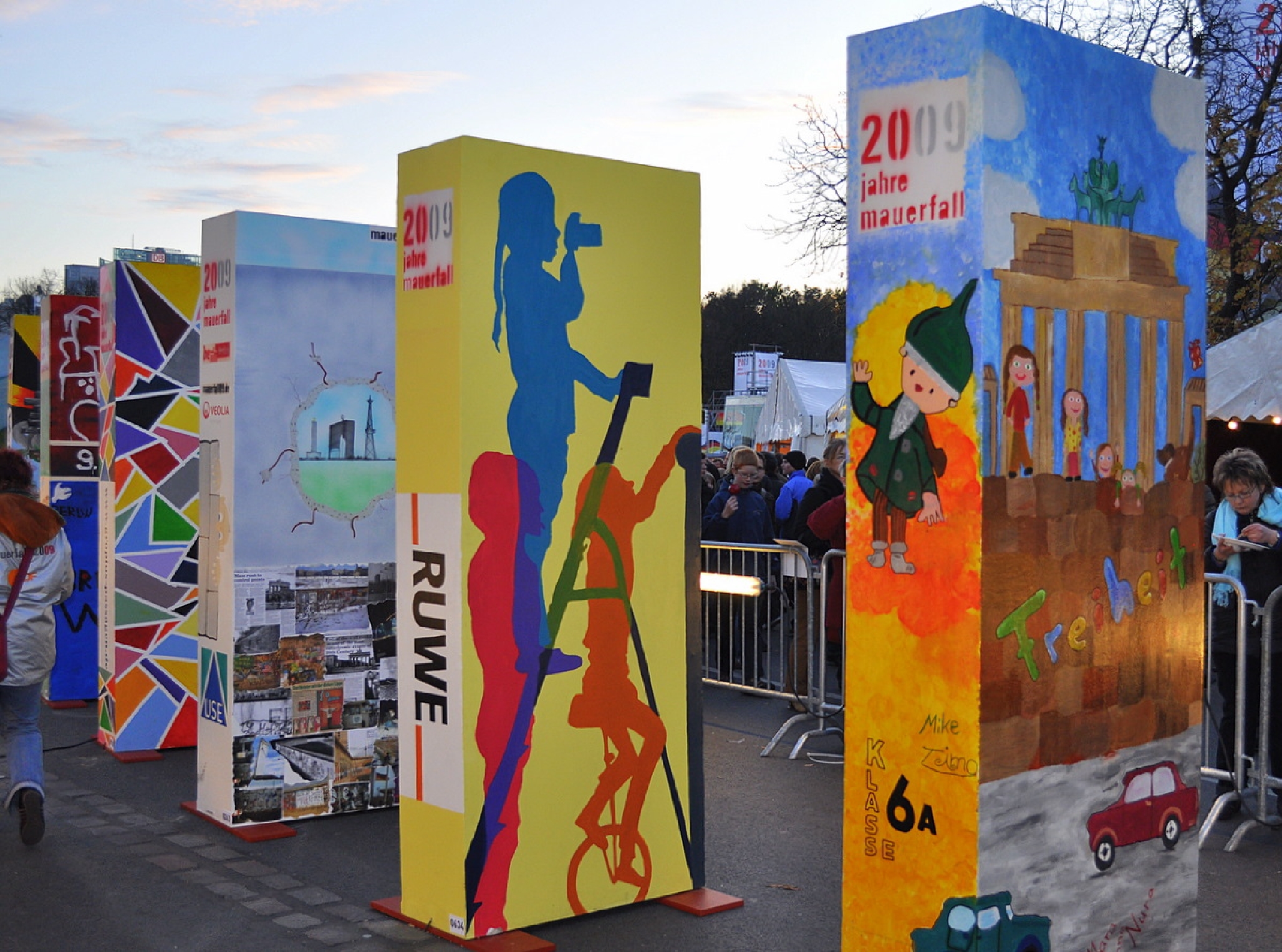



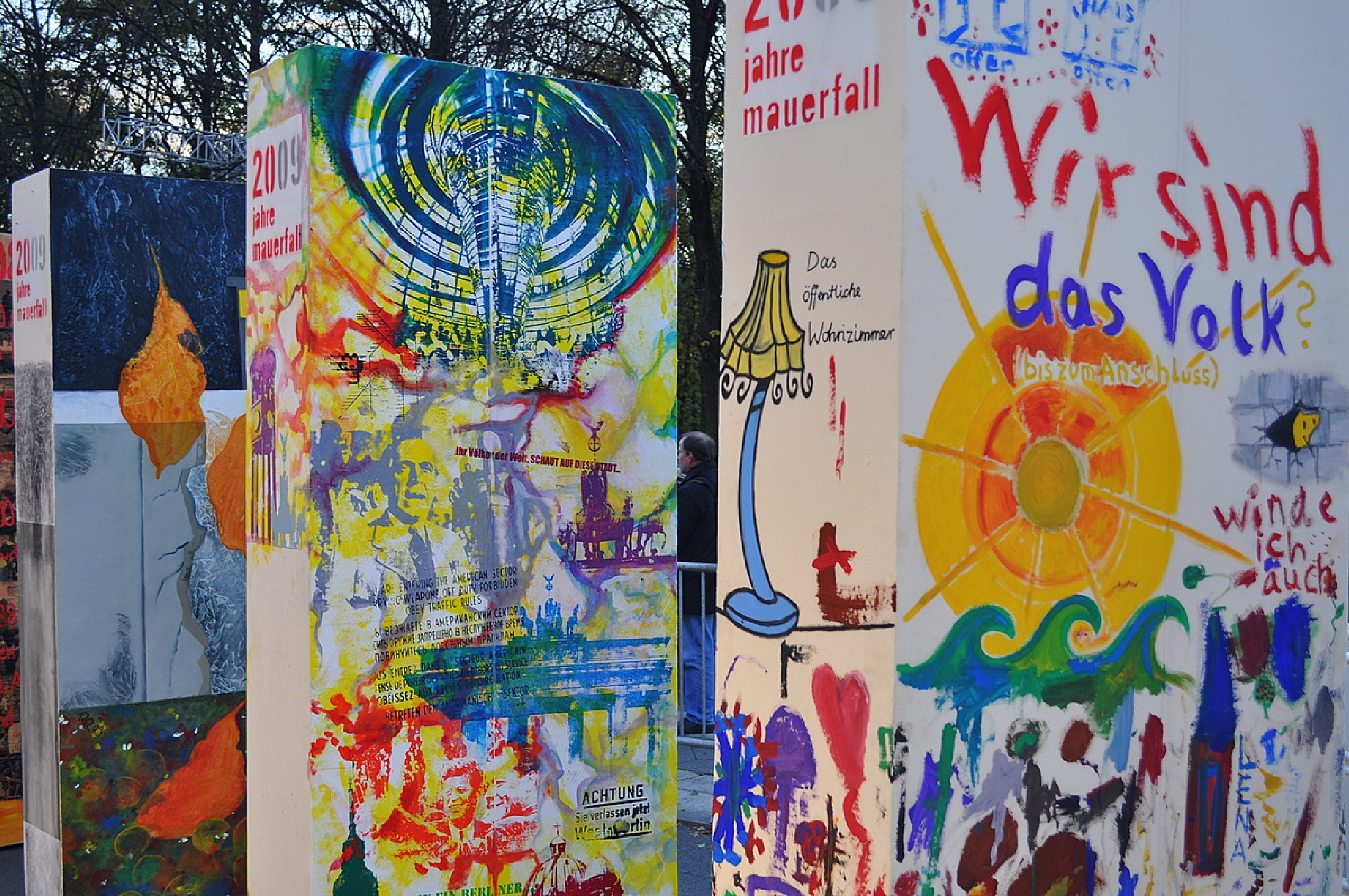
THIS APPROACH WILL CONTINUE WITH THE 25TH ANNIVERSARY of the fall of the Wall. Germany’s current president, Joachim Gauck, had been a member of the East German civil rights movement as a pastor in the northern port city of Rostok in 1989. Early in 2014, Gauck declared his intention to embed the German experience of 1989 more deeply into the broader Central and Eastern European context, emphasizing the shared popular revolutions of 1989 through 1991, more than just the fall of the Wall. (The 20th anniversary celebrations had made these initial connections; Polish Solidarity leader Lech Wałęsa had been given the honor of toppling the first “domino” on the night of November 9, 2009.) This year, Gauck proposed that he and his Polish, Hungarian, Czech, and Slovak counterparts celebrate together the anniversaries of turning points of the 1989 revolutions in their countries.
The heads of state gathered for ceremonies in Warsaw and Budapest in June, met in Germany in October, and will meet again in Bratislava and Prague in November. By choosing to gather in Leipzig on October 9 instead of in Berlin on November 9, Gauck made clear his view — one shared by most members of the former East German opposition — that the key turning point in East Germany was not the opening of the Wall on November 9, 1989, but rather the peaceful demonstration of tens of thousands of citizens in Leipzig on October 9, 1989. In spite of rumors (helped along by East German officials) in early October 1989 that there would be a Tiananmen-esque crackdown against the demonstrators, more than 70,000 turned out on October 9, holding candles and chanting “Keine Gewalt” (“no violence”), marching in peaceful protest along Leipzig’s central ring road. It was a turning point: people overcame their fear of the regime, went onto the streets, and saw that they were not alone. The authorities stood down and did not interfere with the protest. This was the moment that President Gauck chose to highlight for the 25th anniversary this fall.
On November 9, Berlin will be the site of celebrations hosted by Mayor Wowereit and Chancellor Merkel, albeit without all the world leaders who were invited five years ago. At several key sites at the former border, including the Brandenburg Gate, Potsdamer Platz, Checkpoint Charlie, and the East Side Gallery, artists will perform, panels of experts will discuss the Wall and its legacy, and large screens will show historical footage. Using the new iOS app “Mauerschau” (See the Wall), visitors can take an iPhone-guided tour along the Wall’s onetime path, watching recent interviews and archival video as they reach noteworthy sites — “history at the site where it happened,” the app’s website promises. Berlin’s tourism officials expect hundreds of thousands of visitors for the anniversary, and have partnered with Facebook to promote the ceremonies.
The formal events will be broadcasted live on German public television: Chancellor Merkel’s attendance at a morning ecumenical service at the Chapel of Reconciliation at the Berlin Wall Memorial (where Pastor Manfred Fischer had pushed to honor the Wall’s victims for more than two decades), followed by her dedication of a new permanent exhibit on the Berlin Wall; an afternoon ceremony presided over by Major Wowereit at the Konzerthaus on the historic Gendarmenmarkt; and an evening celebration hosted by Chancellor Merkel at the Brandenburg Gate. Music will play a prominent role in the festivities: most notably, Daniel Barenboim will lead the Staatskapelle Berlin orchestra in the same piece that Leonard Bernstein rapturously conducted in Berlin in December 1989, just one month after the Wall fell: the final movement of Beethoven’s Ninth Symphony, the “Ode to Joy.” (There also have been reports that both Madonna and Lady Gaga want to perform at the anniversary, but only if the other does not appear.)
*

On November 7, approximately 8,000 luminescent balloons will be installed along nine miles where the Wall once stood, forming a “border of light” (Lichtgrenze) through central Berlin. The lights are a reminder of the candles that East German protestors held when they took to the streets a generation ago. Germans and others around the world are invited to “sponsor” a balloon with a short message of “hope for a world without walls.” At 100 stations along the nine miles, open-air exhibits will relate personal stories of the rise and fall of the Wall and the division and unification of Germany.
On the evening of November 9, the 8,000 balloons of the Lichtgrenze will be released, and float up into the night sky above Berlin — the dividing line removed once again.
The image of thousands of balloons rising into the air is, perhaps, a fitting way to mark the reduced weight of the past on German shoulders as they embrace a proud moment in their history.
* * *
Hope M. Harrison is an associate professor of history and international affairs at George Washington University’s Elliott School of International Affairs, and a senior fellow with the Wilson Center’s Cold War International History Project and History and Public Policy Program. She is the author of Driving the Soviets up the Wall: Soviet–East German Relations, 1953–1961 (Princeton University Press, 2003) and the forthcoming After the Berlin Wall: Memory and the Making of the New Germany, 1989 to the Present (Cambridge University Press, 2015).
Illustrations by Zack Stanton & Kathy Butterfield.
Cover photo courtesy of the U.S. Department of Defense.
